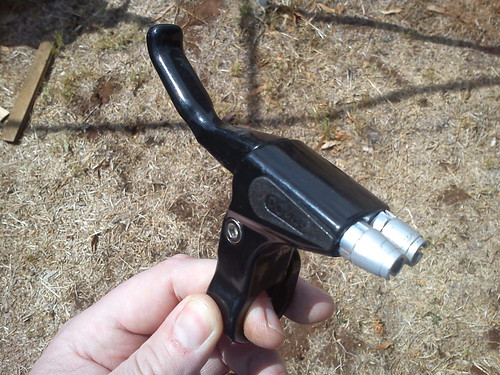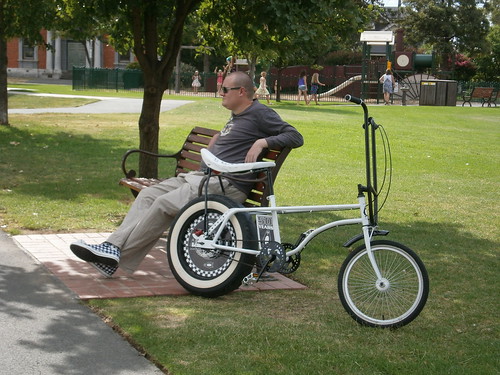Right side shifting would be my biggest hurdle. I have a 1966 Ducati 250 Scrambler with a right side shift which I am rebuilding...I haven't ridden it yet, will take a lot of concentration. I've only ridden 3 or 4 bikes that shift on the right, got scary in a panick situation.
You are using an out of date browser. It may not display this or other websites correctly.
You should upgrade or use an alternative browser.
You should upgrade or use an alternative browser.
Lets see your dual brake setups
- Thread starter Quanah
- Start date

Help Support Rat Rod Bikes Bicycle Forum:
This site may earn a commission from merchant affiliate
links, including eBay, Amazon, and others.
Having owned and ridden more than a couple of Brit-bikes over the years, the factory front brakes were a lot scarier :shock: :x :roll: than the right side shift. Most of them were pretty crappy 'til near the end of production. Being young and immortal at the time  , my first mod tended to be ditching the diode and rectifier plates, and accompanying copper spagetti. :mrgreen:
, my first mod tended to be ditching the diode and rectifier plates, and accompanying copper spagetti. :mrgreen:
The steel hub twin leader 8 inch drum brake from the 68-70 650's and later 500's was a really good stopper. They later replaced it with the aluminum shell conical hub that worked like poop, of course then later a mediocre disc brake.
Getting back to bicycle brakes, my idea of using the mountain bike yoke cable to contract both brakes will not work. There must be a cable housing on each brake cable or they will not actuate.
I thought the disc brakes were kind of boring in appearance when introduced on motorcycles, like the Kawasaki ZL1 900. The disc brakes all looked alike to me, while the big drum brakes had a variety of pork chop shapes, actuator arms and cooling scoops.
I thought the disc brakes were kind of boring in appearance when introduced on motorcycles, like the Kawasaki ZL1 900. The disc brakes all looked alike to me, while the big drum brakes had a variety of pork chop shapes, actuator arms and cooling scoops.
Can't vouch for these companies, but the product is out there.
http://www.bicycle-engines.com/Dual-Pul ... Lever.html
http://store.cycledifferent.com/mm5/mer ... e=ADAPTIVE
http://store.stcago.com/Dual-Pull-Kit-w ... r-p48.html
http://www.bicycle-engines.com/Dual-Pul ... Lever.html
http://store.cycledifferent.com/mm5/mer ... e=ADAPTIVE
http://store.stcago.com/Dual-Pull-Kit-w ... r-p48.html
The dual levers are available on eBay, I used this one on my "50 Years" Muscle bike that ran dual rear wheel discs...


Build thread: viewtopic.php?f=43&t=68143&st=0&sk=t&sd=a
Luke.


Build thread: viewtopic.php?f=43&t=68143&st=0&sk=t&sd=a
Luke.
I cant see any reason why not, you would have to make sure they were both adjusted the same though... Might become more trouble than it is worth over time. Really, unless someone has already tried it, nobody knows for sure...
Luke.
Luke.
doorman, thanks for the leads. Fabbing up one like in the first on that list wouldn't be too difficult. I know that putting 2 caliper brakes on a boardtracker wouldn't exactly look like the 1920's. I should have a 16'' Lemon Peeler front wheel with an Atom drum brake around here, but I can't seem to find it...would be a good drum to lace up to my old steel 26'' rim.
Quanah said:Luke, that's a good looking lever, I'm just needing something that looks much more rustic.
I know its an old thread but I feel strongly about brake functionality.
I kno you want the "look" but on a motorized bike, functionality should be first. I think disc brakes are the best stoppers. If a retro rat look is all that is keeping you from using that dual lever, or a disc brake, think about faux painting it. There is some merit to being able to stop your bike before some idiot hits you... and living to tell about it.
Some boardtrackers may not have had brakes, but they were on a closed circuit, not the street.
A great deal of the board track racers had no brakes at all. I wouldn't seek that level of authenticity.
I messed about with dual brakes on a couple of bikes. I had a load of old bike parts. I had various sizes of Weimmann alloy sidepull callipers. They are marked with a number, such as 1020. that signifies the drop between the spindle that fits in the frame or forks, and the centre of the brakepad. But theres a zero added to it. so 1020 is 102mm. Theres some adjustment in the slot the brake pad bolts too. theres various sizes of brakes. 500, 605, 730,810, 890, 1000, 1020, 1080. Are some I can remember. These numbers are on various other manufacturers brakes, Dia compe, Altenburger, cheapo steel calipers too.
If your building a dual caliper brake onto a frame or fork. You might need 2 different lengths of caliper. Particularly if there mounted on a curved frame tube.
I did find out that most of the brakes I had, there spindle had a lump on it to hold the spring. That was cast as one with the spindle. But on early 70s Weimmann brakes, the lump was pushed onto a 10mm hex nut that was formed onto the spindle. So I could tap it off. then use some 6mm treaded bar, from a hardware shop. 6mm threaded bar is the the same thread as the Weimmann brakes use. A 6mm thread nut, uses a 10mm spanner, so it fits into the spring lump thing. I did find that I had to carefully set up the spindle nuts. I had various thickness of those shaped washers that goes between the frame or fork and the brake. I just used 2 levers. But wanted a lever that pulled 2 cables. I didn't do much with that brake set up.
If your building a dual caliper brake onto a frame or fork. You might need 2 different lengths of caliper. Particularly if there mounted on a curved frame tube.
I did find out that most of the brakes I had, there spindle had a lump on it to hold the spring. That was cast as one with the spindle. But on early 70s Weimmann brakes, the lump was pushed onto a 10mm hex nut that was formed onto the spindle. So I could tap it off. then use some 6mm treaded bar, from a hardware shop. 6mm threaded bar is the the same thread as the Weimmann brakes use. A 6mm thread nut, uses a 10mm spanner, so it fits into the spring lump thing. I did find that I had to carefully set up the spindle nuts. I had various thickness of those shaped washers that goes between the frame or fork and the brake. I just used 2 levers. But wanted a lever that pulled 2 cables. I didn't do much with that brake set up.



